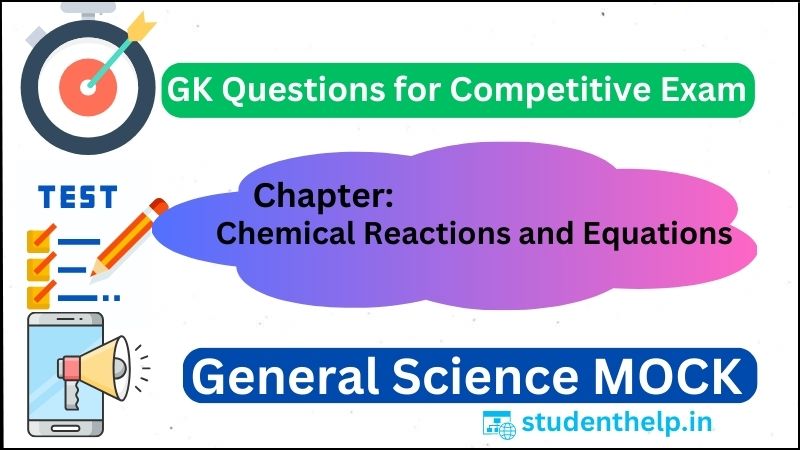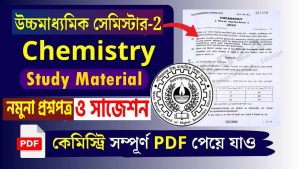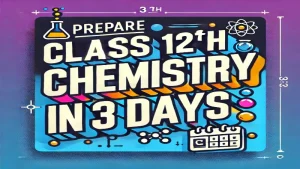Chemical Reactions and Equations MCQ Question
Q1: Which of the following are exothermic processes?
(i) Reaction of water with quick lime
(ii) Dilution of an acid
(iii) Evaporation of water
(iv) Sublimation of camphor (crystals)
(a) (i) and (ii)
(b) (ii) and (iii)
(c) (i) and (iv)
(d) (ii) and (iv)
Show Answer
Answer: (a) (i) and (ii)
Explanation: Calcium hydroxide is produced when water reacts with quick lime, coupled with the release of heat. As a result, the reaction is exothermic. Diluting a concentrated acid is an extremely exothermic process.
Q2: MnO2 + 4HCl → MnCl2 + 2H2O + Cl2
Identify the substance oxidized in the above equation.
- (a) MnCl2
- (b) HCl
- (c) MnO2
- (d) H2O
Show Answer
Answer: (b) HCl
Explanation: Here HCl is oxidized to Cl2 and MnO2 is reduced to MnCl2.
Q3: Which of the following is an endothermic process?
(a) Dilution of sulphuric acid
(b) Condensation of water vapours
(c) Sublimation of dry ice
(d) Respiration in human beings
Show Answer
Answer: (c) Sublimation of dry ice
Explanation: Sublimation of ice is an immediate phase transition from solid to gas without having to pass through an intermediate liquid state. Because the process requires additional energy, it is an endothermic reaction, and the heat absorbed is referred to as heat of sublimation.
Q4: What type of chemical reactions take place when electricity is passed through water?
(a) Displacement
(b) Decomposition
(c) Combination
(d) Double displacement
Show Answer
Answer: (b) Decomposition
Explanation: Electrolysis of water is a decomposition reaction.
Q5: Which of the statements about the reaction below are incorrect ?
2 PbO(s) + C(s) → 2Pb (s) + CO2(g)
(a) Lead is getting reduced.
(b) Carbon dioxide is getting oxidised.
(c) Carbon is getting oxidised.
(d) Lead oxide is getting reduced.
(i) (a) and (b)
(ii) (a) and (c)
(iii) (a), (b) and (c)
(iv) All
Show Answer
Answer: (i) (a) and (b)
Q6: What happens when dilute hydrochloric acid is added to iron filings ? Tick the correct answer:
(a) Hydrogen gas and iron chloride are produced.
(b) Chlorine gas and iron hydroxide are produced.
(c) No reaction takes place.
(d) Iron salt and water are produced.
Show Answer
Answer: (a) Hydrogen gas and iron chloride are produced.
Q7: Translate the following statements into chemical equations and then balance them.
(a) Hydrogen gas combines with nitrogen to form ammonia.
(b) Hydrogen sulphide gas burns in air to give water and sulphur dioxide.
(c) Barium chloride reacts with aluminium sulphate to give aluminium chloride and a precipitate of barium sulphate.
(d) Potassium metal reacts with water to give potassium hydroxide and hydrogen gas
Show Answer
Answer:
(a) 3H2 (g) + N2 (g) → 2NH3 (g)
(b) H2S (g) + 3O2 (g) → SO2 (g) + 2H2O(l)
(c) 3BaCl2 (aq) + Al2(SO4)3 (aq) → 2AlCl3 (aq) + 3BaSO4 ↓(s)
(d) 2K (s) + 2H2O (l) → 2KOH (aq) + H2 (g)
Q8: Balance the following chemical equations:
(a) HNO3 + Ca (OH)2 → Ca (NO3)2 + H2O
(b) NaOH + H2SO4 → Na2SO4 + H2O
(c) NaCl + AgNO3 → AgCl + NaNO3
(d) BaCl2 + H2SO4 → BaSO4 + HCl
Show Answer
Answer:
(a) 2HNO3 + Ca(OH)2 → Ca(NO3)2 + 2H2O
(b) 2NaOH + H2SO4 → Na2SO4 + 2H2O
(c) NaCl + AgNO3 → AgCl + NaNO3
(d) BaCl2 + H2SO4 → BaSO4 + 2HCl
Q9: Write the balanced chemical equation for the following and identify the type of reaction in each case:
(a) Potassium bromide (aq) + Barium iodide (aq) → Potassium iodide (aq) + Barium
(b) Zinc carbonate(s) → Zinc oxide (s) + Carbon dioxide (g) bromide(s)
(c) Hydrogen (g) + Chloride (g) → Hydrogen chloride (g)
(d) Magnesium (s) + Hydrochloric acid (aq) → Magnesium chloride (aq) + Hydrogen (g)
Show Answer
Answer:
(a) 2KBr (aq) + Bal2(aq) → 2Kl(aq) + BaBr2(s)
Type : Double displacement reaction
Q10: Which of the following gases can be used for storage?
(a) Carbon dioxide or Oxygen
(b) Helium or Nitrogen
(c) Carbon dioxide or Helium
(d) Nitrogen or Oxygen
Show Answer
Answer: (b) Helium or Nitrogen
Explanation: Because helium, as well as nitrogen, prevent the oil from becoming rancid, they can be used to store a fresh sample of oil for a long time. The use of nitrogen or helium as a blanketing gas prevents air and oil contact.









Helpful content. Please read some tropic of class 10 science